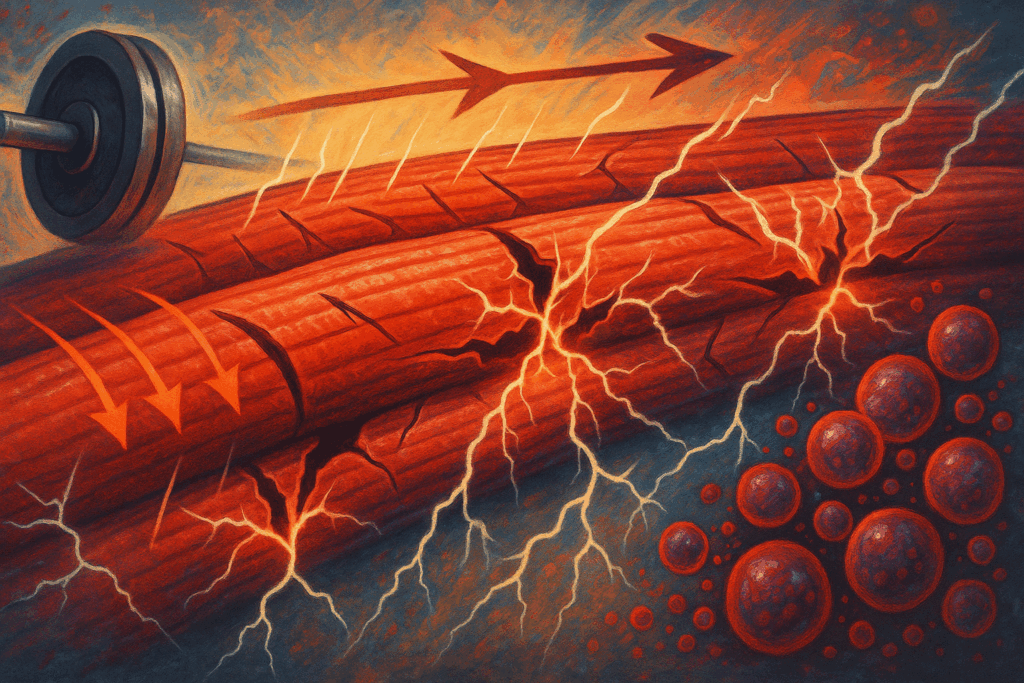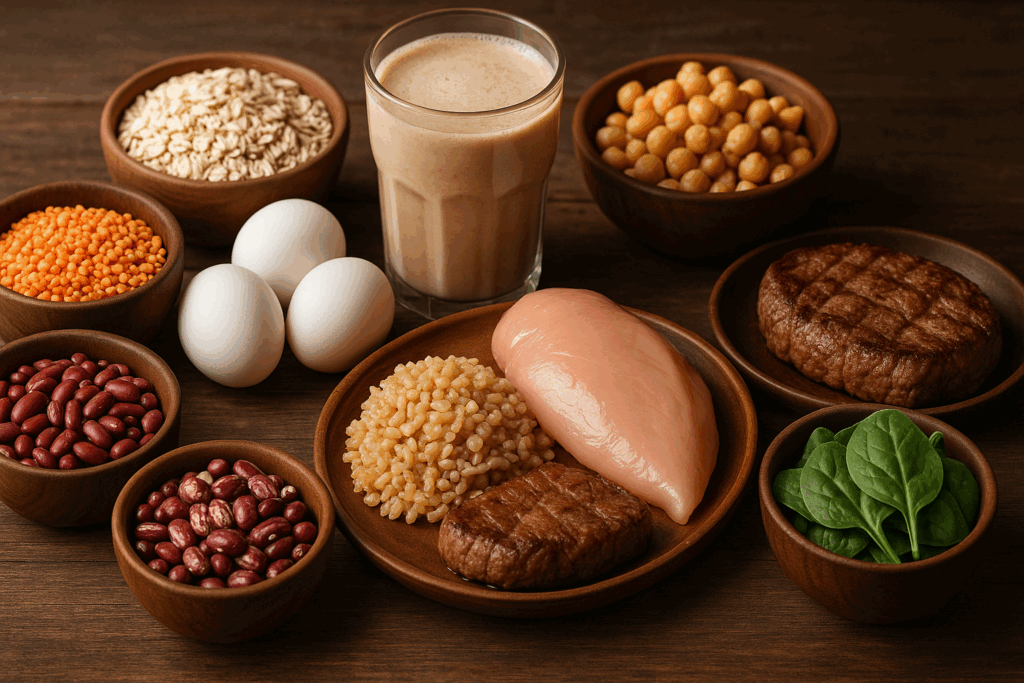Achieving significant strength gains while staying within the realm of drug-free training is both a science and an art. Natural hypertrophy programs offer a structured, evidence-based path for individuals committed to building muscle and power without the use of performance-enhancing drugs. These programs are tailored to work with the body’s natural hormonal cycles, recovery capacity, and nutrient utilization, providing a sustainable and effective route to long-term progress. This guide explores everything from the biological underpinnings of hypertrophy to the practical design of training programs, nutrition strategies, and recovery principles that support natural muscle growth.
You may also like: The Ultimate Hypertrophy Workout Program for Building Strength and Size

Understanding the Science of Natural Hypertrophy
Muscle hypertrophy refers to the enlargement of muscle cells, a process driven by mechanical tension, muscle damage, and metabolic stress. These three stimuli signal the body to repair and reinforce muscle fibers, making them thicker and stronger. In the context of natural hypertrophy programs, the goal is to maximize these stimuli within the constraints of the body’s endogenous hormone production and recovery limits.
Mechanical tension arises from lifting heavy weights, particularly under slow, controlled movement. This tension challenges the muscle’s ability to contract, leading to greater recruitment of motor units. Muscle damage, on the other hand, results from eccentric loading—the lowering phase of a lift—which creates micro-tears in muscle fibers. Metabolic stress, characterized by the burning sensation during high-rep sets, is linked to the accumulation of lactate and other metabolites that also signal muscle growth.
For drug-free lifters, balancing these factors becomes critical. Unlike enhanced athletes, who can recover rapidly and tolerate high volumes and frequencies, natural lifters must strategically manage their training intensity, volume, and rest to avoid overtraining. Effective natural hypertrophy programs take these biological realities into account, prioritizing progressive overload, exercise variation, and adequate recovery periods.

Structuring Natural Hypertrophy Programs for Maximum Results
Designing an effective natural hypertrophy program requires a nuanced approach that integrates periodization, frequency, and exercise selection. Periodization involves organizing training into distinct phases, each with a specific focus, such as strength, volume, or deloading. This approach helps prevent plateaus and reduces the risk of overtraining by cycling intensity and workload over time.
A typical natural hypertrophy program might begin with a foundational strength phase, emphasizing low-rep, high-load movements like squats, deadlifts, and presses. This builds neural efficiency and joint stability, laying the groundwork for subsequent hypertrophy-specific training. The next phase would shift to moderate-rep ranges (8–12 reps), higher volumes, and a greater variety of accessory exercises to maximize muscular development.
Frequency is another critical variable. While some muscle groups may recover within 48 hours, others might require longer. Most natural hypertrophy programs aim for a training frequency of 2–3 times per week per muscle group, allowing for sufficient stimulus without compromising recovery. Full-body routines, upper/lower splits, and push-pull-legs (PPL) are popular formats that can be tailored to individual recovery capacity and training schedules.
Exercise selection should prioritize compound lifts that engage multiple muscle groups, as these provide the greatest mechanical tension and hormonal response. Supplementing these with isolation movements allows for targeted volume and symmetry. Over time, rotating exercises prevents adaptive resistance and promotes continuous progression.

Natural Hypertrophy Programs and the Role of Nutrition in Muscle Growth
No hypertrophy program can succeed without a solid nutritional foundation. Nutrition fuels training, facilitates recovery, and supports the anabolic processes necessary for muscle growth. For natural athletes, optimizing macronutrient intake—especially protein and carbohydrates—is essential to maximize gains.
Protein intake is a cornerstone of hypertrophy nutrition. Current evidence suggests that natural lifters aiming for muscle growth should consume 1.6 to 2.2 grams of protein per kilogram of body weight per day. This range supports muscle protein synthesis (MPS) and helps repair damaged muscle tissue. High-quality protein sources such as eggs, lean meats, dairy, and plant-based options like tofu and legumes provide the necessary amino acid profiles.
Carbohydrates are equally vital, as they replenish glycogen stores depleted during training and stimulate insulin, a hormone with anabolic properties. Consuming 3 to 6 grams of carbohydrates per kilogram of body weight, depending on training volume, helps support performance and recovery. Fats, while not the primary fuel source for hypertrophy, are important for hormone production, particularly testosterone, and should not fall below 20% of total caloric intake.
Meal timing and nutrient distribution also play a role. While the anabolic window may not be as narrow as once believed, consuming protein and carbohydrates within a few hours of training enhances recovery. Spreading protein intake across 4 to 6 meals per day, each containing 20–40 grams of protein, ensures a consistent supply of amino acids and maximizes MPS throughout the day.

Programming Recovery and Rest in Natural Hypertrophy Programs
Recovery is where adaptation occurs. Without sufficient rest, even the most well-structured training and nutrition plans will fail to produce optimal results. Natural hypertrophy programs place a strong emphasis on rest days, sleep quality, and stress management, all of which contribute to recovery and muscle growth.
Sleep is arguably the most important recovery tool. During deep sleep, the body releases growth hormone and repairs damaged tissues. Natural lifters should aim for 7 to 9 hours of quality sleep each night, prioritizing consistency in bedtime and wake time, as well as creating an environment conducive to rest—cool, dark, and quiet.
Rest days are not wasted days. They are an essential component of muscle growth. Incorporating one or two rest days per week, or using active recovery modalities such as walking, yoga, or light swimming, helps reduce systemic fatigue and prepares the body for subsequent training sessions. Some advanced natural hypertrophy programs include deload weeks every 4 to 6 weeks, where training intensity or volume is significantly reduced to facilitate recovery.
Managing psychological stress is also vital. Chronic stress elevates cortisol, a catabolic hormone that can interfere with muscle growth and recovery. Techniques such as mindfulness, breathing exercises, and hobbies that promote relaxation help support an anabolic internal environment. The best natural hypertrophy programs are those that acknowledge and accommodate the lifestyle and recovery demands of the individual.
Building Strength Naturally: Balancing Neural and Muscular Adaptation
Strength gains are not solely the result of muscle size. Neural adaptations, such as improved motor unit recruitment, synchronization, and firing rate, play a crucial role, particularly in the early stages of training. Natural hypertrophy programs that integrate strength-focused blocks alongside hypertrophy phases can leverage both neural and muscular adaptations for optimal progress.
Incorporating low-rep, high-load lifts at 80–95% of one-rep max (1RM) builds maximal strength and trains the nervous system to fire more efficiently. This type of training should be reserved for foundational compound movements, such as the squat, deadlift, bench press, and overhead press. These lifts should be performed with strict attention to form, progressive loading, and adequate rest intervals to ensure safety and effectiveness.
Alternating strength and hypertrophy phases over mesocycles (typically 4 to 6 weeks each) allows the nervous system to recover from high-intensity loading while shifting focus to muscle growth. This approach also maintains variety, reduces mental burnout, and promotes long-term adherence to the program. Ultimately, combining neural and hypertrophic adaptations creates a synergistic effect that results in powerful, functional strength gains.

Progressive Overload and the Long-Term Success of Natural Hypertrophy Programs
Progressive overload is the cornerstone of all effective training. It refers to the gradual increase in training stimulus to continually challenge the muscles and drive adaptation. In the context of natural hypertrophy programs, this principle must be applied intelligently to account for the slower rate of recovery and adaptation compared to enhanced lifters.
There are multiple ways to implement progressive overload, including increasing the load (weight), repetitions, sets, or reducing rest intervals. However, not all progress is linear. Especially for experienced natural lifters, progress may occur in waves or require periods of consolidation before further advancement. Tracking workouts and monitoring performance trends are essential for identifying when and how to increase the challenge.
Using a combination of linear and undulating periodization can help avoid stagnation. Linear periodization gradually increases intensity over time, while undulating periodization varies intensity and volume from session to session. Both methods can be effective, and the best choice often depends on the individual’s training history, goals, and preferences.
Avoiding excessive fatigue is also important. Natural hypertrophy programs must strike a balance between stimulus and recovery. Training to failure, for example, should be used sparingly and strategically. Overreliance on this method can lead to neural fatigue and diminished performance, especially without pharmaceutical recovery aids. Instead, most sets should be completed with 1–2 reps in reserve (RIR), preserving technique and energy while still providing a strong growth signal.
Real-World Application of Natural Hypertrophy Programs: Training for Lifelong Gains
One of the defining characteristics of natural hypertrophy programs is their sustainability. These programs are not about short-term transformations or rapid bulking cycles. They are about building a foundation of strength and muscle that can be maintained for life. This approach requires a long-term mindset, emphasizing consistency, patience, and enjoyment of the process.
Customization is key. No two lifters are alike, and effective natural hypertrophy programs are those that reflect the unique needs, preferences, and limitations of the individual. Some may thrive on high-frequency training, while others need more rest. Some may prefer bodyweight and free-weight movements, while others respond best to machines. The underlying principles remain the same, but the implementation must be flexible.
Staying injury-free is another pillar of long-term success. Natural lifters do not have the luxury of accelerated recovery, so injury prevention takes on greater importance. Warm-ups, mobility work, and proper technique should be non-negotiables in every training session. Additionally, listening to the body and being willing to adjust intensity or take an extra rest day when needed is a mark of training maturity, not weakness.
Psychological factors also play a major role. Motivation, discipline, and mindset can make or break a training journey. Cultivating intrinsic motivation—a desire to improve for personal growth and health—tends to yield more consistent long-term results than extrinsic motivations like aesthetics alone. Celebrating small victories, tracking progress, and staying connected to a supportive training community can enhance enjoyment and adherence.
Natural Hypertrophy Programs for Different Training Levels
While the core principles of natural hypertrophy remain consistent, program design should vary depending on the trainee’s experience level. Beginners, intermediates, and advanced lifters each have different needs in terms of volume, frequency, and complexity.
Beginners often benefit from full-body routines performed three times per week. These programs emphasize fundamental movement patterns, moderate volume, and consistent practice of basic lifts. Progress is typically rapid due to the novelty of the stimulus and untapped neural efficiency. For these lifters, simplicity and adherence matter more than nuanced programming.
Intermediate lifters may need more variation and specificity. This is where upper/lower or PPL splits become useful, allowing for increased training volume while preserving recovery. Exercise selection should become more refined, targeting weaknesses and incorporating more advanced techniques like tempo work, supersets, and paused reps. Progress slows slightly but remains steady with well-managed overload.
Advanced lifters face the greatest challenge. With years of training behind them, adaptations come slowly, and progress requires precise manipulation of variables. Periodization becomes more sophisticated, involving macrocycles (yearly plans), mesocycles (monthly blocks), and microcycles (weekly variations). Deloads, autoregulation, and advanced intensity techniques become tools for eking out continued gains. At this level, natural hypertrophy programs demand not only physical effort but intellectual engagement and continuous refinement.

Optimizing Hormonal Health for Natural Hypertrophy Success
Hormones play a critical role in muscle growth and recovery. While natural lifters do not use exogenous hormones, they can still optimize their internal hormonal environment through lifestyle choices, training practices, and nutrition. Understanding the key hormones involved in hypertrophy—testosterone, growth hormone, insulin, and cortisol—helps inform smarter training and recovery strategies.
Testosterone supports muscle protein synthesis and strength development. While genetics determine baseline levels, lifestyle factors like sleep, resistance training, healthy fat intake, and stress management can influence natural production. Compound lifts and high-intensity training have been shown to transiently increase testosterone levels, particularly when rest intervals are kept moderate.
Growth hormone, secreted during deep sleep and in response to exercise, enhances tissue repair and fat metabolism. Sleep hygiene, fasting protocols, and lactate-inducing training (such as high-rep sets) can support its release. Insulin, though often maligned, is anabolic when properly timed. Post-workout carbohydrate intake enhances glycogen replenishment and facilitates amino acid transport into cells, supporting recovery and growth.
Cortisol, the body’s primary stress hormone, has catabolic effects when chronically elevated. While short-term spikes during intense training are normal and necessary, chronic stress, under-recovery, and sleep deprivation can lead to muscle breakdown. Monitoring stress, using relaxation techniques, and ensuring proper nutrition help maintain a favorable hormonal balance for hypertrophy.
Frequently Asked Questions: Deep Insights into Natural Hypertrophy Programs
What are the long-term psychological benefits of following natural hypertrophy programs?
Natural hypertrophy programs don’t just build stronger bodies—they foster stronger minds as well. The discipline required to adhere to structured training and nutrition regimens often translates into improved emotional resilience and self-regulation. Over time, individuals following these programs may experience reduced symptoms of anxiety and depression, largely due to consistent physical activity, social reinforcement, and a growing sense of self-efficacy. The incremental nature of progress in natural hypertrophy also nurtures patience and goal-setting behavior, which are transferable to other areas of life such as career development and interpersonal relationships. Many long-term adherents report an enhanced sense of identity and personal mastery that persists far beyond the gym.
How do natural hypertrophy programs impact joint health and longevity?
Unlike aggressive training programs that prioritize rapid bulk at any cost, natural hypertrophy programs emphasize sustainable progression, often resulting in better joint preservation over time. Because these programs are built around the body’s natural capacity to recover and adapt, they typically avoid the excessive loads and poor biomechanics that lead to chronic wear and tear. Incorporating movements with controlled tempo, proper warm-ups, and adequate mobility work helps reinforce connective tissue strength and neuromuscular control. This approach not only reduces injury risk in the short term but also contributes to improved functional mobility into older age. Long-term participants often maintain a higher quality of life due to the protective effects of controlled hypertrophic loading on joint and musculoskeletal health.
Can natural hypertrophy be optimized using wearable technology and biofeedback tools?
Yes, recent advances in wearable technology have created new avenues for optimizing natural hypertrophy. Devices that track heart rate variability (HRV), sleep cycles, and movement patterns can provide critical insights into readiness, recovery, and training efficacy. For example, if a wearable indicates elevated resting heart rate and poor sleep quality, a lifter might adapt their natural hypertrophy program by reducing volume or prioritizing recovery strategies. Some advanced tools now offer muscle oxygenation metrics and real-time performance tracking, which can inform more precise training adjustments. The integration of biofeedback into natural hypertrophy programs allows for a more personalized and responsive approach, enabling lifters to align their programming with daily physiological fluctuations and long-term trends.
How do natural hypertrophy programs differ for women compared to men?
While the foundational principles of natural hypertrophy apply to all genders, women may benefit from unique adaptations in programming due to hormonal, biomechanical, and recovery differences. Women generally recover faster between sets and sessions, which can support higher training frequencies or shorter rest intervals. Natural hypertrophy programs tailored to women often emphasize glute and posterior chain development, areas that many women prioritize aesthetically and functionally. Hormonal cycles, especially in menstruating women, can affect energy levels, strength, and recovery, suggesting the utility of periodized programming that aligns with these fluctuations. Furthermore, resistance training in natural hypertrophy programs can help women counteract age-related bone density loss and preserve metabolic health, particularly post-menopause.
What are the economic and lifestyle advantages of following natural hypertrophy programs?
Natural hypertrophy programs offer a financially sustainable path to strength and muscle development because they eliminate the need for costly performance-enhancing drugs and their associated medical risks. The reduced likelihood of injury also means fewer healthcare costs and less time off work or daily responsibilities. From a lifestyle perspective, these programs support long-term wellness habits, promoting consistency in exercise, diet, and sleep hygiene. The time investment tends to be more manageable due to intelligent volume and frequency structuring, allowing individuals to balance training with careers, family, and social commitments. Over time, the consistent gains made through natural hypertrophy lead to improved confidence, productivity, and energy—all without the financial or ethical compromises associated with unnatural methods.
Are there any overlooked recovery techniques that enhance results in natural hypertrophy?
Absolutely. While most natural hypertrophy programs emphasize sleep, nutrition, and rest days, several lesser-known recovery modalities can further support progress. Contrast therapy, which alternates between hot and cold exposure, may improve circulation and reduce inflammation, expediting recovery between sessions. Myofascial release using foam rollers or massage balls can help alleviate tightness and improve muscle elasticity, enhancing range of motion during lifts. Additionally, breathwork and parasympathetic activation techniques, such as diaphragmatic breathing or meditation, can reduce cortisol levels and accelerate hormonal recovery. Nutrient timing beyond protein—such as magnesium and glycine before sleep—can also support nervous system restoration and muscle repair. These techniques, when used strategically, can significantly enhance the quality of recovery without adding mechanical stress.
How can older adults benefit from natural hypertrophy programs without increasing injury risk?
Older adults can thrive with natural hypertrophy programs, provided the programs are intelligently designed to align with age-related physiological changes. These adaptations might include using moderate weights with higher reps to reduce joint strain while still promoting muscle growth. Emphasizing eccentric control and stability work can help improve proprioception and prevent falls or musculoskeletal injuries. Additionally, prioritizing exercises that reinforce posture and core strength—such as rows, bird dogs, and farmer’s carries—can mitigate age-related decline in spinal integrity and balance. Natural hypertrophy in older adults also supports glucose regulation, cardiovascular health, and cognitive function. The key lies in gradual progression, regular functional assessments, and maintaining an emphasis on form and joint-friendly movement patterns.
What role does mental imagery play in enhancing strength gains in natural hypertrophy?
Mental imagery, or visualization, can be a powerful supplement to physical training in natural hypertrophy programs. Research in sports psychology shows that mentally rehearsing a lift can activate the same neural pathways as actual physical performance, reinforcing motor learning and neural efficiency. Athletes who visualize themselves executing movements with precision often see improved real-world performance due to enhanced neuromuscular coordination. Additionally, imagery can boost confidence and reduce performance anxiety, particularly during strength testing or personal records. For natural lifters who rely heavily on neural adaptation in the early stages of strength development, incorporating mental imagery into their routine may accelerate progress without increasing training volume or risking overtraining.
How do community and social support influence adherence to natural hypertrophy programs?
Adherence is often the most critical factor in long-term success with any fitness program, and natural hypertrophy programs are no exception. Being part of a supportive community—whether through online forums, in-person training partners, or coaching groups—can significantly increase motivation and accountability. Social support provides opportunities for knowledge sharing, technique feedback, and emotional encouragement during plateaus or setbacks. Many lifters find that celebrating small milestones within a community helps maintain enthusiasm over the slow progression often associated with natural hypertrophy. Furthermore, mentorship and shared experiences create a sense of belonging and purpose, reinforcing the discipline required for consistent training and recovery. In essence, a strong social network can be the catalyst that transforms a solitary effort into a lifelong lifestyle.
What are future trends and innovations emerging in natural hypertrophy programming?
Natural hypertrophy is evolving rapidly thanks to advancements in exercise science, digital coaching, and artificial intelligence. One emerging trend is the use of machine learning to generate dynamic, individualized programming that adapts to real-time performance data. Wearables and smart gym equipment now offer nuanced feedback on bar velocity, muscle activation, and training load, allowing lifters to fine-tune their sessions for optimal adaptation. Virtual reality (VR) and augmented reality (AR) tools are being explored for immersive training environments and real-time form correction. Additionally, research into epigenetics may soon allow natural hypertrophy programs to be tailored to an individual’s genetic profile, optimizing training response and recovery. These innovations promise to make natural hypertrophy both more effective and more personalized, without sacrificing the integrity of drug-free development.
Conclusion: Committing to Lifelong Strength with Natural Hypertrophy Programs
Natural hypertrophy programs represent more than just a training method—they embody a philosophy of sustainable, evidence-based growth that respects the body’s natural capabilities and limitations. Through intelligent programming, optimal nutrition, and strategic recovery, drug-free athletes can achieve impressive and lasting strength gains without compromising their health or integrity.
Whether you are just beginning your journey or refining your approach after years of lifting, the principles outlined in this guide offer a roadmap for maximizing results. By embracing progressive overload, prioritizing recovery, and tailoring your program to your individual needs, you set the stage for consistent and meaningful progress.
In a fitness culture often obsessed with shortcuts and extremes, natural hypertrophy programs stand out as a powerful, principled alternative. They empower you to build strength not only in your muscles but in your mindset, habits, and long-term health. With commitment, patience, and the right knowledge, the journey toward natural strength can be both rewarding and transformative—a true testament to what the human body can achieve through discipline, science, and hard work.





